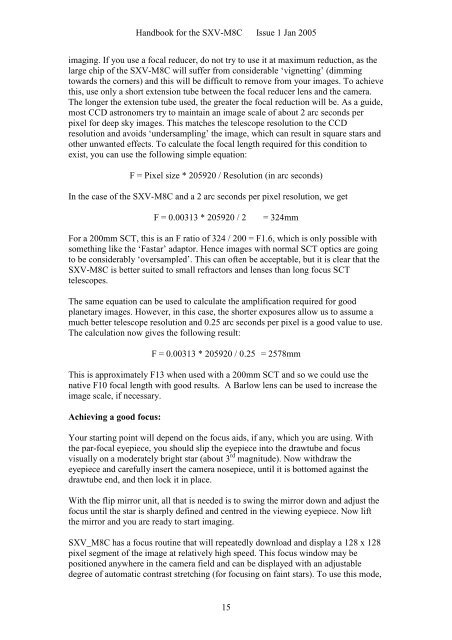SXV-M8C handbook.pdf - Starlight Xpress
SXV-M8C handbook.pdf - Starlight Xpress
SXV-M8C handbook.pdf - Starlight Xpress
- No tags were found...
Create successful ePaper yourself
Turn your PDF publications into a flip-book with our unique Google optimized e-Paper software.
Handbook for the <strong>SXV</strong>-<strong>M8C</strong> Issue 1 Jan 2005imaging. If you use a focal reducer, do not try to use it at maximum reduction, as thelarge chip of the <strong>SXV</strong>-<strong>M8C</strong> will suffer from considerable ‘vignetting’ (dimmingtowards the corners) and this will be difficult to remove from your images. To achievethis, use only a short extension tube between the focal reducer lens and the camera.The longer the extension tube used, the greater the focal reduction will be. As a guide,most CCD astronomers try to maintain an image scale of about 2 arc seconds perpixel for deep sky images. This matches the telescope resolution to the CCDresolution and avoids ‘undersampling’ the image, which can result in square stars andother unwanted effects. To calculate the focal length required for this condition toexist, you can use the following simple equation:F = Pixel size * 205920 / Resolution (in arc seconds)In the case of the <strong>SXV</strong>-<strong>M8C</strong> and a 2 arc seconds per pixel resolution, we getF = 0.00313 * 205920 / 2= 324mmFor a 200mm SCT, this is an F ratio of 324 / 200 = F1.6, which is only possible withsomething like the ‘Fastar’ adaptor. Hence images with normal SCT optics are goingto be considerably ‘oversampled’. This can often be acceptable, but it is clear that the<strong>SXV</strong>-<strong>M8C</strong> is better suited to small refractors and lenses than long focus SCTtelescopes.The same equation can be used to calculate the amplification required for goodplanetary images. However, in this case, the shorter exposures allow us to assume amuch better telescope resolution and 0.25 arc seconds per pixel is a good value to use.The calculation now gives the following result:F = 0.00313 * 205920 / 0.25 = 2578mmThis is approximately F13 when used with a 200mm SCT and so we could use thenative F10 focal length with good results. A Barlow lens can be used to increase theimage scale, if necessary.Achieving a good focus:Your starting point will depend on the focus aids, if any, which you are using. Withthe par-focal eyepiece, you should slip the eyepiece into the drawtube and focusvisually on a moderately bright star (about 3 rd magnitude). Now withdraw theeyepiece and carefully insert the camera nosepiece, until it is bottomed against thedrawtube end, and then lock it in place.With the flip mirror unit, all that is needed is to swing the mirror down and adjust thefocus until the star is sharply defined and centred in the viewing eyepiece. Now liftthe mirror and you are ready to start imaging.<strong>SXV</strong>_<strong>M8C</strong> has a focus routine that will repeatedly download and display a 128 x 128pixel segment of the image at relatively high speed. This focus window may bepositioned anywhere in the camera field and can be displayed with an adjustabledegree of automatic contrast stretching (for focusing on faint stars). To use this mode,15
















